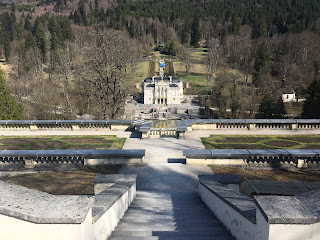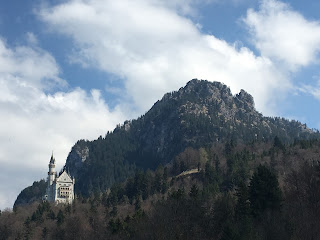I love castles. Always and forever. And let me just say, Mad King Ludwig's rank among the best. I find the countrysides of places like Germany and Austria generally stunning, so I was happy as a princess clam that the weather held up and we had booked a tour to two of Ludwig's famous abodes. It was another early start, but once we got on the bus, we were ready for a day of visual decadence.
The first stop on the tour was actually a small village called Oberammergau, known for its lavish production of the Passion Play. It was first performed in 1634 to ward off the Bubonic Plague which had been devastating Europe. The citizens of the town vowed to perform the Passion Play every ten years in exchange for immunity from the plague. The vow ultimately proved successful and so the town continues to host the event in a massive production every decade. The other unique part of the village are the many frescos artfully painted on the facades of many of the houses. The illustrated scenes range from fairy tale stories to traditional Bavarian scenes. I immediately decided that, should I ever own a house, it will absolutely be painted with images of fairy tales.
We finally made it to our first crazy castle, which was surprisingly smaller than I had anticipated: Linderhof Palace. Despite its size, the castle is by far one of the most extravagant I've ever seen. It is essentially a shrine to the Sun King, Louis XIV. King Ludwig was fascinated by his power and majesty. Although he was a notorious recluse with incredibly strange habits, Ludwig delighted in surrounding himself by utter grandeur. You can't take pictures within the castle but if the exterior is any indication, you can get a sense of the detail. The walls are covered top to bottom with decoration and there's even a smaller version of the Hall of Mirrors from Versailles. Most intriguingly, you get to catch a glimpse of Ludwig's remarkable dining table. He was so averse to being around other people in his later years that he didn't even want his servants to see him. Instead, he had a table made which was lifted directly from the kitchens to his small dining room. The cooks and servants could prepare and clean the table before and after it was pulleyed up to the King.
The second castle, Neuschwanstein, is most known these days for being a prime inspiration for Disney castles. The turrets and pillars cut a stunning figure from the mountains of Bavaria. I really would have no problem living there except for the fact that it is certainly not the easiest place to get to. It is quite a steep walk from the main strip of town up to the castle. Fortunately, en route there is a beautiful bridge that allows for the most picturesque photos imaginable. Once again, pictures are not allowed on the interior but you have a pretty good idea of the type of ornamentation within. Though slightly less ornate than Linderhof, Neuschwanstein also has a notable theme. The castle is a striking homage to the operettist, Richard Wagner, with whom Ludwig was wildly obsessed. In the end, King Ludwig spent so much money on his outlandish castles that the Bavarian ministers had to cut him off and demand he cease the building lunacy. To this day it is unclear if his mysterious death was natural, suicide, or murder.
By the time we got back to Munich, I was overflowing with thoughts of royal pageantry. It was a glorious day in the Bavarian countryside, perfectly well spent. For dinner, Hot Blonde Cousin and I had some traditional German fare at the Wirtshaus Ayingers before heading over to the famous Hofbräuhaus for a night cap. Schlösser and wiener schnitzel. Danke, King Ludwig!







































































































No comments:
Post a Comment